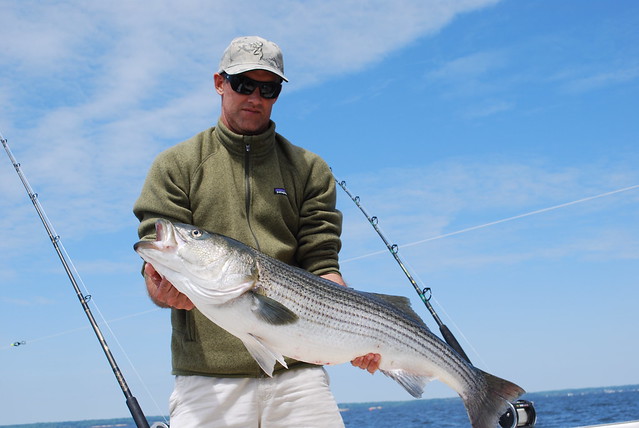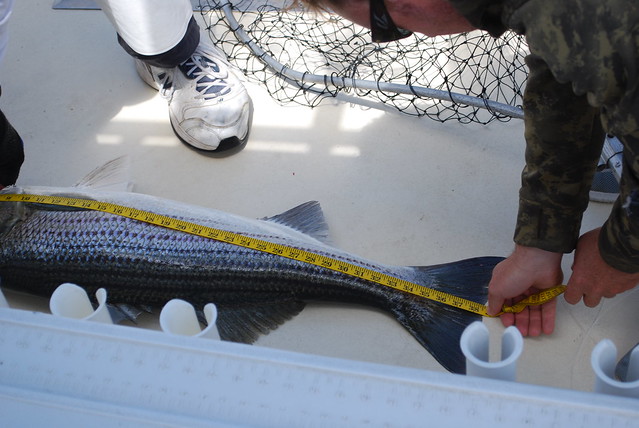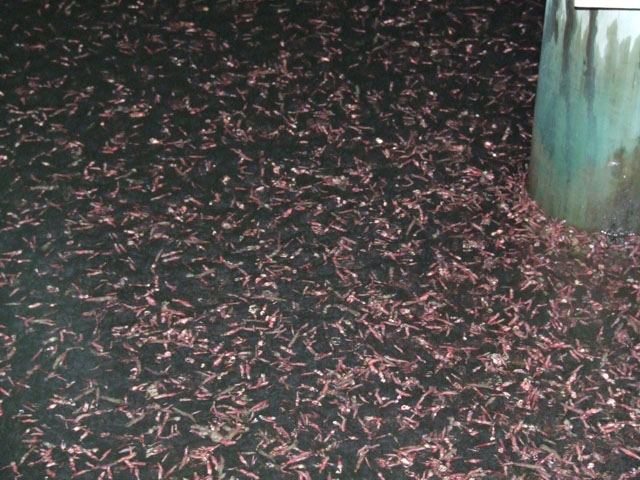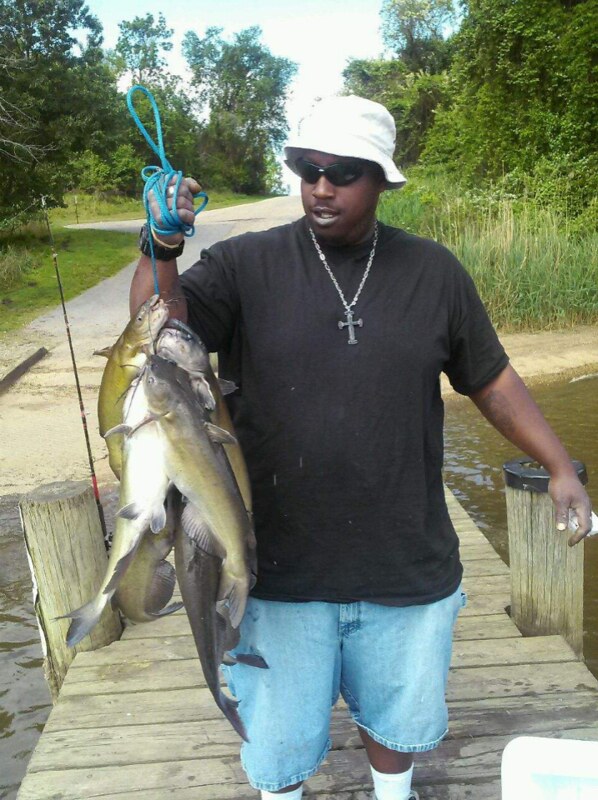By: Keith Lockwood
It is so easy for us to take for granted all of the bountiful things we have here in Maryland since many of us have never known anything else or it is just part of our lives. Those that travel to other parts of the country or the world certainly know and often can't wait to get back home. Recently I had the privilege to help host a group of outdoorsmen from Tanzania who are PH's (the guys who take and protect you on a hunting safari) and they are also avid fishermen. Basically they were amazed and just shook their heads at all of the greenery, beautiful rivers and bays and of course some of our wonderful fishing opportunities we have here in Maryland. This past Friday we spent some time trolling along the eastern side of the shipping channel and all of them caught some beautiful striped bass. Darren Smit takes a long lasting look at a nice striped bass he caught and although the fish stayed in Maryland the memories will travel with him where ever he may go.

Photo by Keith Lockwood
The Conowingo Dam is presently on an afternoon/evening power generation schedule so fishing up close to the dam should be better in the morning hours. The white perch have been coming on strong in the lower Susquehanna River and although the throwback ratio may be high, there is plenty of action. The American shad fishing near the dam has been tapering off and the hickory shad spawning runs are about over. Striped bass fishing around the Susquehanna Flats area has been good this week and since May 16th one striped bass between 20" and 26" can be kept per day. This slot size on the flats continues through May 31st and then follows the bay wide regulations of two striped bass at 20" or over with only one being allowed over 28".
Striped bass size regulations for the rest of Maryland's portion of the Chesapeake Bay took a friendly turn on May 16th and there is no longer a 36" to 40" slot. Striped bass will have to be 20" or larger to be legal and the traditional creel limit of two striped bass per day remains. As in the past only one of those two fish can be over 28" in length. There are still sections of the tidal spawning rivers that are not open to striped bass fishing until June 1st and the following striped bass map link can help clarify the boundaries. Hopefully now anglers will not have to sweat as much when they lay out their fish to be measured. All eyes were on the person with the tape measure during this past trophy season and the lucky angler secretly crossing his fingers. Fortunately for this angler when the tape was pulled to the nose of the fish it measured just over 40" total length.

Photo by Keith Lockwood
Trolling for trophy sized striped bass is slowing down in the upper bay and has settled into what could be described as a slow pick. The steep channel edges near Love Point, Sandy Point and down to the Bay Bridge continue to be popular places to troll. Striped bass at 20" or longer to 28" are now fair game and medium sized bucktails are an important part of any trolling spread. Not everyone in the upper bay is trolling for their striped bass as chumming/chunking and jigging over suspended fish becomes a more common way to catch fish. Warmer water temperatures are also enticing medium sized striped bass to cruise around shorelines and within reach of shoreline anglers and those enjoying casting lures along shoreline structure.
In the middle bay region there is still some trolling for large striped bass occurring with ever diminishing returns for hours spent working the channel edges. Bloody Point and Thomas Point remain popular as is the western and eastern sides of the shipping channel. One should take note that commercial crabbers have been setting trot lines of crab pots along the shipping channel edges and they can ruin anyone's day if you blunder into a set with a full trolling spread. The ones I've seen near the CR Buoy recently were marked with yellow flags. A good tidal current is very important when working these edges and overhead sun helps also. The water temperatures in the middle bay region have moved into the 72° range now, water clarity is still very good and the thermocline is holding at around 30'. There is plenty of bait being swept along the channel edges during times of swift tidal currents in the form of menhaden, blueback herring and hickory shad. Most are sticking to their large bucktails and parachutes dressed with sassy shads trolled either in tandem or behind and umbrella rig but large soft plastic swim shad type lures are a good addition to any spread. Medium sized bucktails and swim shad type lures should also be in a trolling spread for those striped bass 28" or under. Brian Byrd is certainly happy with his nice 41" striped bass and has entered his fish into the Maryland Fishing Challenge.

Photo Courtesy of Brian Byrd
White perch are filling in areas where we commonly see them during the summer months and can provide good fishing fun around the lower sections of the regions tidal rivers. Black Drum will begin to attract the attention of those with a notion for some heavy action with these large fish. Soft crabs are now available and places like the Sharps Island or James Island Flats are the places to begin to look for them. Croakers will be arriving shortly as will spot. Yesterday the bay water temperature was 72° in the middle bay area.
The warmer water temperatures make it about perfect for striped bass to move into the shallower areas along shorelines and structure such as sunken rip rap and dock piers. Cool temperatures will allow the good fishing to start earlier in the day and extend later in the mornings. The shallow water striped bass fishery is one of the finest light tackle experiences anywhere; whether you are using light spinning tackle or fly casting.
Anyone with a dock light will know that the May worms are swarming in their annual spawning process. They are actually our common clam worm which can grow to be 6" long and lives on the bottom of the bay. We often see small ones when we dig through a bushel of oysters; they will look like little centipedes. During May they go through a metamorphosis and become the free swimming worms we see rising to the surface on a moonless night. They are a very important food item for bottom dwelling fish and crabs in their original state and of course fish such as striped bass and white perch will gorge on them during their spawning period. Rob White sent us this picture of a massive group of May worms swarming around his dock.

Photo by Rob White
In the lower bay region most of the trolling action has been taking place near Cove Point and Point No Point on the western side of the shipping channel and near the HS Buoy and Buoy 72. Medium sized striped bass are also a target now and there have been some catches in Tangier Sound and the lower Potomac River as well as the shipping channel edges. Most boats are now pulling a mixed spread of medium and large bucktails and parachutes. Some boats have also been wandering over north of the Target ship and trolling large spoons with success for some catch and release action with large red drum.
The croakers have arrived in the lower Potomac River and the Point Lookout area. The Tangier and Pocomoke Sound area also report good croaker catches. They are being caught off the Point Lookout Pier or at the mouth of the Wicomico River. Those fishing at the mouth of the Wicomico River will also find blue catfish to be a large part of their catch. The medium size blue catfish make for excellent eating. Many of the croakers being caught tend to be on the small size and many anglers will be looking for the larger ones to fill in during the upcoming weeks. A variety of baits such as bloodworms, peeler crab or shrimp will work. When using shrimp, make sure you purchase wild shrimp and not the freshwater aquiculture variety. This happy angler was fishing from shore at Point Lookout when he caught this nice striped bass.

Courtesy of Roberto Bembo
White perch are being caught in just about every tidal creek and river in the lower bay region on a variety of small lures and baits. Fishermen on the Eastern Shore are also fishing for speckled sea trout along the marsh cuts and tidal creeks.
Recreational crabbers have been having limited success in the tidal creeks and rivers along the middle and lower Eastern Shore recently. Most recreational crabbers are reporting around four dozen crabs per outing. The first shed of this season is occurring and hopefully larger crabs are in the pipeline for the upcoming weeks.
Deep Creek Lake is slowing warming up and lake water temperatures are holding around 65° this week with some slightly warmer water in the shallower cove areas. Largemouth bass are actively spawning now in the coves and along shallower shorelines. Floating docks are being deployed making for good places to target for largemouth and smallmouth bass. Drifting minnows under a slip bobber is a great way to catch large yellow perch and walleye this week in some of the deeper areas along deep grass or rocky bottom areas.
John Mullican was kind enough to send us a report on fishing from the upper Potomac River where water temperatures are close to 70°. Smallmouth fishing has been steady with the majority of the bass 12" with a few larger fish 15 - 20". Many of the bass have been actively spawning and are guarding beds or fry. Not all fish spawn at the same time or even spawn for that matter, so look for non-spawning fish in main river boulder and rubble bottom areas below riffles. Top water lures, tubes, and stick worms have been effective.
Largemouth bass are done spawning in most areas of Maryland except the far western region. Water temperatures are cool enough that they can be found in the shallows well into the day as the bass try to build up body stores after spawning. Grass beds, the mouths of creeks feeding into tidal rivers and submerged structure are all good places to target with a variety of lures. Topwater action is always the most fun with poppers, chatterbaits and frogs. When fishing the tidal Potomac or some of the tidal waters on the Eastern Shore watch out for the explosive strikes of northern snakeheads since they are holding in shallow grass beds prior to spawning.
Bluegill sunfish and other species of sunfish are close to being finished with spawning and can be found outside of grass beds or lily pad fields. They offer some great fly fishing opportunities when casting small rubber-legged poppers or ants. Of course the old worm or cricket under a bobber is a given when fishing for bluegills; especially with youngsters.
Crappie can still be found near deep structure such as fallen tree tops and a minnow or small jig under a slip bobber is the ticket to some fun fishing. There is also plenty of opportunity for catfish in many of the states tidal waters. Channel catfish can be found in most of the tidal rivers of the Chesapeake and the lower Potomac has an abundance of blue catfish. Flathead catfish can be found near the Conowingo Dam on the lower Susquehanna River. Sheldon Flood holds a nice stringer of channel catfish he caught recently on the Patuxent River.

Photo Courtesy of Sheldon Flood
The Ocean City area continues to experience excellent fishing for bluefish in a variety of sizes. Off the beaches and in and around the inlet large bluefish are being caught and then there is another set of smaller bluefish in the same areas. Surf casters are generally using bottom rigs baited with cut menhaden or finger mullet. There also some large striped bass being caught and this fishery will greatly improve as post spawn Chesapeake Bay striped bass move up the coast.
Inside the inlet and around the Route 50 bridge area large bluefish are being caught on bucktails being cast from shore. Tautog are being caught along jetties, bulkheads and bridge piers on sand fleas or pieces of green crab. Flounder fishing remains good as long as the wind does not chop the water up too much and cause cloudy water conditions. Gulp baits as well as minnows and squid are all working well along channel edges, especially on an ebbing tide.
Sea bass fishing has been very good on the wreck and reef sites offshore with most boats boasting several limit catches per trip. Farther offshore along the 30 fathom line thresher, mako and blue sharks are being caught by those who are chumming. At the canyons the boats who are trolling are catching some nice yellowfin tuna in the 50 lb class and bluefin tuna around 80 lbs. Successful anglers are reminded that they need to fill out HMS catch cards upon returning to port for tuna, billfish and shark catches. There is a 24 hour drop off box at the West Ocean City Maryland DNR office at Harbor Road South.
Boom...Morgan
No comments:
Post a Comment